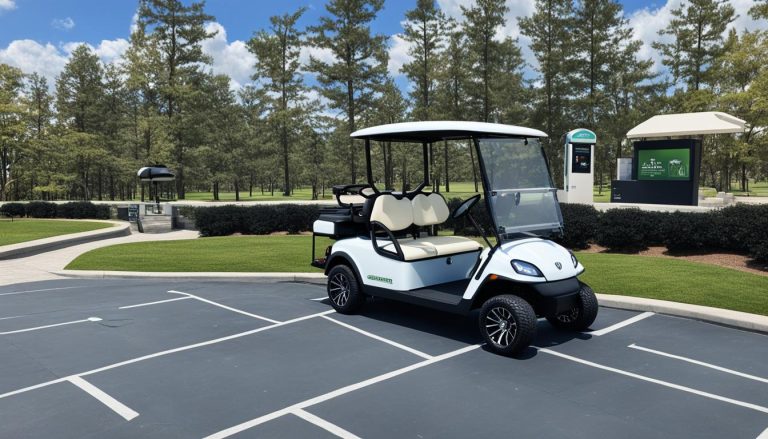Charge Frequency for Golf Cart Batteries Unveiled
batterychargers.site and its partners may earn a commission if you purchase a product through one of our links
Extending the life of your golf cart battery is essential for optimal performance and protection of your investment. To achieve this, it is crucial to understand the proper charging guidelines and maintenance practices for your battery. By following a charge schedule that suits your specific needs, you can significantly prolong the lifespan of your golf cart battery.
Key Takeaways:
- Regular monitoring and preventative maintenance are key to maximizing golf cart battery life.
- Follow the operating instructions provided with your golf cart’s charging equipment for the best results.
- Charge your battery immediately after a complete discharge for extended longevity.
- Maintain proper water levels and avoid overwatering to prevent diminished battery performance.
- If issues arise, reach out to customer support or a battery specialist for troubleshooting tips and assistance.
Charging Guidelines for Golf Cart Batteries
Proper charging practices are essential for extending the life and optimizing the performance of your golf cart batteries. By following recommended guidelines, you can ensure that your batteries remain in great condition for years to come.
Here are some best practices for charging golf cart batteries:
- Charging Frequency: To maintain optimal battery performance, it is recommended to charge your golf cart batteries after every complete discharge. Regular charging prevents deep discharges, which can lead to irreversible damage.
- Safety Precautions: Always prioritize safety when charging your batteries. Make sure to turn off the charger before connecting it to the batteries to prevent any electrical mishaps. Additionally, allow your batteries to warm to room temperature before charging to avoid thermal stress.
- Watering Maintenance: Watering your golf cart batteries is important for their longevity. Use distilled or de-mineralized water and avoid overwatering, as excess water can negatively affect battery performance.
Following these guidelines will help optimize the charging process and ensure that your golf cart batteries remain in excellent condition.
Comparison of Recommended Charging Intervals
| Charging Interval | Recommended | Optimal Frequency |
|---|---|---|
| After Complete Discharge | Yes | Daily or After Each Use |
| Partial Discharge | No | Not Necessary, But Can Top-Up |
| Overnight Charging | No | Recommended Only Occasionally |
| Extended Storage | No | Charge Batteries Before & After Storage Period |
Remember, for the best performance and longevity of your golf cart batteries, it is important to follow these charging guidelines consistently. By doing so, you can maximize the lifespan of your batteries and enjoy reliable operation on the course.
Preventative Maintenance for Golf Cart Batteries
To extend the life of your golf cart battery, preventative maintenance is crucial. By following a regular maintenance schedule, you can ensure optimal battery performance and longevity. Here are some important steps to include in your maintenance routine:
- Keep battery covers and terminals clean: Regularly clean the battery covers and terminals to prevent the buildup of dirt, grime, and corrosion. Use a biodegradable cleaning solution and a wire brush to gently scrub the terminals and remove any debris.
- Inspect and tighten battery connections: Check all battery connections to ensure they are secure and free from any loose or corroded terminals. Tighten any loose connections to maintain a consistent flow of power.
- Check specific gravity and open circuit voltage: Regularly monitor the specific gravity and open circuit voltage of your golf cart battery. These readings can provide valuable insights into the battery’s charge level and overall health. Refer to the manufacturer’s guidelines for specific gravity and voltage ranges.
Regular maintenance and monitoring are key to maintaining the performance and longevity of your golf cart battery. By implementing these preventive measures, you can enjoy reliable performance on the greens for years to come.
In addition to these steps, it’s important to adhere to a consistent charging schedule for your golf cart batteries. Charging your batteries too often or not frequently enough can affect their performance and lifespan. It’s recommended to consult your manufacturer’s guidelines to determine the optimal charging frequency for your specific batteries.
| Maintenance Steps | Recommended Frequency |
|---|---|
| Cleaning battery covers and terminals | Monthly |
| Inspecting and tightening battery connections | Monthly |
| Checking specific gravity and open circuit voltage | Every 3 months |

Troubleshooting Golf Cart Batteries
Even with proper maintenance, golf cart batteries can encounter issues that affect their performance. It is important to troubleshoot and address these problems promptly to ensure optimal battery function. Here are some common troubleshooting steps:
Checking for Visible Issues
Inspecting your golf cart batteries for any visible issues is the first step in troubleshooting. Look for any loose or defective connectors that may hinder the battery’s performance. Additionally, check the electrolyte levels and ensure they are not too low, as this can impact battery efficiency.
Proper Charging
Ensuring proper charging techniques is crucial for maintaining battery performance. Follow the recommended charging guidelines for your specific golf cart battery, taking into account the optimal charge frequency and duration. Incorrect charging methods can lead to battery damage and diminished capacity.
Maintaining Suitable Operating Temperatures
Golf cart batteries perform best within a specific temperature range. Extreme temperatures, both hot and cold, can negatively impact battery performance and lifespan. Therefore, it is essential to store and operate your golf cart within the recommended temperature range to avoid potential issues.
Seeking Professional Assistance
If you encounter persistent battery performance issues or are unsure about the troubleshooting steps, it is advisable to seek assistance from customer support or a battery specialist. They can provide you with expert guidance and additional troubleshooting tips to resolve the problem.
Remember, proper maintenance and proactive troubleshooting are key to maximizing the performance and lifespan of your golf cart batteries.

| Common Golf Cart Battery Issues | Possible Causes | Recommended Solutions |
|---|---|---|
| Battery fails to hold a charge | – Defective connectors – Low electrolyte levels – Faulty charger |
– Check and tighten connectors – Refill electrolyte levels if low – Test charger functionality or replace if necessary |
| Inconsistent power output | – Battery sulfation – Overcharging or undercharging |
– Perform a desulfation process – Verify proper charging techniques and adjust as needed |
| Poor battery performance in extreme temperatures | – Exposure to extreme heat or cold | – Store golf cart in a temperature-controlled environment – Use insulating materials to protect the battery from temperature extremes |
| Uneven battery cell voltage | – Cell imbalance – Internal battery damage |
– Balance cell voltages using equalization techniques – If internal damage is suspected, consider battery replacement |
Reviving Dead Batteries – Separating Fact from Fiction
Reviving dead golf cart batteries is a common concern among golf cart owners. With so many online videos and hacks claiming to have the ultimate solution, it’s important to separate fact from fiction to avoid potential damage to the battery and ensure legitimate battery performance improvement.
One common hack involves adding substances like Epsom salt, baking soda, or aspirin to the battery cells in an attempt to revive dead batteries. However, it’s important to note that there is limited scientific evidence to support the effectiveness of these methods. In fact, they can potentially do more harm than good.
“Adding substances like Epsom salt, baking soda, or aspirin to the battery cells may not actually improve battery performance and can potentially damage the battery.”
Pulse charging techniques, on the other hand, have been proven to be effective for reviving sulfated batteries. Sulfation occurs when lead sulfate crystals build up on the battery plates, leading to reduced capacity and poor performance. Pulse charging uses short bursts of high current to break down these crystals and restore battery function.
However, it’s crucial to use the right equipment and follow proper techniques when attempting to revive a dead battery using pulse charging. Incorrect usage can lead to further battery damage and potential safety risks.
In most cases, it is recommended to consult a professional for battery revival attempts. They have the expertise and specialized equipment to safely assess the battery’s condition and employ suitable revival techniques.
When it comes to battery performance improvement, it’s essential to focus on preventive maintenance, such as regular charging and maintenance schedules, proper watering, and overall battery care. These practices can help ensure the longevity and optimal performance of your golf cart battery.
Reviving Dead Batteries – Common Myths and Misconceptions
There are several common myths and misconceptions surrounding battery revival. Let’s debunk them and uncover the truth:
- Myth 1: Epsom salt, baking soda, or aspirin can revive dead batteries.
- Myth 2: Overcharging can revive dead batteries.
- Myth 3: Reversing the battery’s polarity can revive dead batteries.
While these substances are often touted as miracle solutions, they may not actually improve battery performance and can potentially cause damage.
Overcharging a dead battery can lead to further damage and potentially hazardous situations. It’s important to follow proper charging techniques and utilize suitable equipment.
Reversing the polarity of a dead battery can result in irreversible damage and render the battery unusable. This technique should be avoided.
Consult the Experts for Battery Revival
If you find yourself with a dead golf cart battery, it’s always best to consult a professional. They have the knowledge, experience, and proper equipment to accurately assess the battery’s condition and determine the best course of action for revival or replacement.
| Battery Revival Techniques | Effectiveness | Cautions |
|---|---|---|
| Pulse charging | Effective for sulfated batteries | Requires proper equipment and techniques to avoid further damage |
| Adding substances (Epsom salt, baking soda, aspirin) | Unproven effectiveness | Potential to damage the battery |
| Consulting a professional | Recommended for accurate assessment and safe revival attempts | Expertise and specialized equipment required for optimal results |
Testing Golf Cart Batteries
Regularly testing the health and performance of your golf cart batteries is crucial to ensure optimal performance and longevity. By using different testing methods, you can gather valuable information about the battery’s condition and make informed decisions regarding maintenance or replacement. Here are some effective methods to check the health of your golf cart batteries:
1. Specific Gravity Testing
The specific gravity of the electrolyte solution in your golf cart battery can reveal important insights about its condition. Using a hydrometer, you can measure the specific gravity of the battery’s electrolyte, which indicates the state of charge and overall battery health. Low specific gravity readings may indicate a discharged or sulfated battery.
2. Load Testing
Load testing involves applying a heavy load to the battery and observing how it performs under stress. This test helps assess the battery’s capacity and its ability to deliver power consistently. During load testing, ensure that the battery voltage remains stable and doesn’t drop significantly, indicating a healthy battery.
3. Voltage Testing
Measuring the voltage of your golf cart battery is a simple yet effective method to check its health. Using a digital voltmeter, you can measure the voltage across the battery terminals. Compare the obtained voltage reading with the battery manufacturer’s specifications to determine if the battery is in good condition.
4. Discharge Testing
Discharge testing involves fully discharging the battery and measuring the time it takes to reach a specific voltage threshold. This test helps assess the battery’s capacity and overall performance. A healthy battery should be able to hold a charge for the expected duration without significant voltage drop.
By regularly performing these tests, you can identify any potential issues with your golf cart batteries and take appropriate measures to maintain their performance. Remember to follow safety precautions and consult the manufacturer’s guidelines or seek professional assistance if needed.
“Testing the health and performance of golf cart batteries is crucial to ensure optimal performance and longevity.”
Maintaining Water Levels in Golf Cart Batteries
Proper water levels in golf cart batteries are crucial for their long-term performance. To ensure optimal battery function, it is important to check and maintain the water level regularly. Here’s what you need to know.
Checking the Water Level
To check the water level in your golf cart batteries, follow these steps:
- Ensure that the golf cart is parked on a level surface and the battery compartment is accessible.
- Open the battery compartment and locate the battery cells.
- Remove the cell covers or caps.
- Visually inspect the water level in each cell.
If the water level is below the lead element or close to the minimum level mark, it’s time to refill the batteries.
Refilling the Batteries
To refill your golf cart batteries, follow these guidelines:
- Use only distilled water to avoid mineral buildup.
- Carefully add water to each cell until the level reaches about an inch from the top.
- Avoid overfilling, as it can lead to acid overflow during charging.
- Replace the cell covers or caps securely.
Regularly monitoring and refilling the water level in your golf cart batteries will help maintain their performance and prolong their lifespan.
| Benefits of Maintaining Proper Water Levels: |
|---|
| 1. Improved battery performance and longevity |
| 2. Minimized risk of battery damage |
| 3. Prevention of acid overflow during charging |
Signs of Good and Poor Golf Cart Batteries
When it comes to assessing the condition of your golf cart batteries, there are several key indicators to keep an eye on. Checking the voltage is an essential step in determining battery health. A consistently low voltage may indicate that your batteries are no longer performing optimally and may need to be replaced.
Visible signs of deterioration should also be taken into consideration. Look out for any bulging or leaking batteries, as well as corroded terminals. These signs can indicate that the batteries are failing and may need to be replaced.
Ensuring secure connections is another important aspect of battery maintenance. Loose or damaged connections can not only affect the battery’s performance but also pose safety risks. Regularly inspect the battery terminals and cables to ensure they are securely attached and free from corrosion.
Monitoring the charging duration and power output is crucial. If you notice that your batteries are taking longer to charge or are not holding a charge as well as they used to, it could be a sign of failing batteries. Diminished performance in terms of power output while driving the golf cart can also be an indicator of battery deterioration.
To accurately assess your golf cart batteries and explore replacement options, it is recommended to seek professional assistance. They can provide an accurate assessment of their condition and help you make an informed decision to ensure the optimal performance of your golf cart.
FAQ
How often should I charge my golf cart batteries?
It is recommended to charge the batteries immediately after a complete discharge.
What are the best practices for charging golf cart batteries?
Follow the operating instructions included with your golf cart’s charging equipment. Safety precautions should be taken, such as turning off the charger before connecting it to the battery and allowing the battery to warm to room temperature before charging.
How frequently should I charge my golf cart batteries?
Regular monitoring and preventative maintenance are key to ensuring optimal battery performance and longevity.
How should I maintain my golf cart batteries?
Keep battery covers and terminals clean and free of corrosion, use biodegradable cleaning solutions for cleaning terminals, inspect and tighten all battery connections, and regularly check the specific gravity and open circuit voltage of the battery.
What should I do if I encounter issues with my golf cart batteries?
Check for visible issues such as defective connectors or low electrolyte levels. Proper charging and ensuring suitable operating temperatures are also vital. If issues persist, reach out to customer support or a battery specialist for troubleshooting tips and assistance.
Are there any effective methods to revive dead golf cart batteries?
Adding substances like Epsom salt, baking soda, or aspirin to the battery cells may not actually improve battery performance and can potentially damage the battery. Pulse charging techniques can be effective for sulfated batteries, but it is necessary to use proper equipment and techniques. It is generally recommended to consult a professional for battery revival attempts.
How can I test the health and performance of my golf cart batteries?
There are various methods to test golf cart batteries, including measuring the specific gravity of the electrolyte solution, load testing, voltage testing, and discharge testing. Regular testing is important to ensure optimal battery performance.
What should I do to maintain water levels in my golf cart batteries?
Regularly check and refill water, use distilled water instead of tap water, and avoid overfilling the battery. Dropping water levels can lead to battery damage and reduced lifespan.
How can I determine the condition of my golf cart batteries?
Check the voltage, look for visible signs of deterioration, ensure secure connections, and monitor charging duration and power output. If the voltage is consistently low, there are visible signs of damage, connections are loose, or the battery’s performance is significantly reduced, it may be time to replace the batteries. Seek professional assistance for accurate assessment and replacement options.






